
The Project Gutenberg EBook of The Engineering Contributions of Wendel Bollman, by Robert M. Vogel This eBook is for the use of anyone anywhere at no cost and with almost no restrictions whatsoever. You may copy it, give it away or re-use it under the terms of the Project Gutenberg License included with this eBook or online at www.gutenberg.org Title: The Engineering Contributions of Wendel Bollman Author: Robert M. Vogel Release Date: October 20, 2010 [EBook #33912] Language: English Character set encoding: ISO-8859-1 *** START OF THIS PROJECT GUTENBERG EBOOK THE ENGINEERING *** Produced by Colin Bell, Joseph Cooper, Louise Pattison and the Online Distributed Proofreading Team at http://www.pgdp.net
This is Paper 36 from the Smithsonian Institution United States National Museum Bulletin 240, comprising Papers 34-44, which will also be available as a complete e-book.
The front material, introduction and relevant index entries from the Bulletin are included in each single-paper e-book.
Inconsistencies in punctuation have been corrected without note. Inconsistent hyphenation is as per the original.

SMITHSONIAN PRESS
MUSEUM OF HISTORY AND TECHNOLOGY
Contributions
From the
Museum
of History and
Technology
Papers 34-44
On Science and Technology
SMITHSONIAN INSTITUTION · WASHINGTON, D.C. 1966
Publications of the United States National Museum
The scholarly and scientific publications of the United States National Museum include two series, Proceedings of the United States National Museum and United States National Museum Bulletin.
In these series, the Museum publishes original articles and monographs dealing with the collections and work of its constituent museums—The Museum of Natural History and the Museum of History and Technology—setting forth newly acquired facts in the fields of anthropology, biology, history, geology, and technology. Copies of each publication are distributed to libraries, to cultural and scientific organizations, and to specialists and others interested in the different subjects.
The Proceedings, begun in 1878, are intended for the publication, in separate form, of shorter papers from the Museum of Natural History. These are gathered in volumes, octavo in size, with the publication date of each paper recorded in the table of contents of the volume.
In the Bulletin series, the first of which was issued in 1875, appear longer, separate publications consisting of monographs (occasionally in several parts) and volumes in which are collected works on related subjects. Bulletins are either octavo or quarto in size, depending on the needs of the presentation. Since 1902 papers relating to the botanical collections of the Museum of Natural History have been published in the Bulletin series under the heading Contributions from the United States National Herbarium, and since 1959, in Bulletins titled “Contributions from the Museum of History and Technology,” have been gathered shorter papers relating to the collections and research of that Museum.
The present collection of Contributions, Papers 34-44, comprises Bulletin 240. Each of these papers has been previously published in separate form. The year of publication is shown on the last page of each paper.
Frank A. Taylor
Director, United States National Museum
Robert M. Vogel
EARLY CAREER 80
THE BOLLMAN TRUSS 85
W. BOLLMAN AND COMPANY 91
FINAL USE OF THE BOLLMAN TRUSS 95
KNOWN BOLLMAN WORKS 99
BIBLIOGRAPHY 104
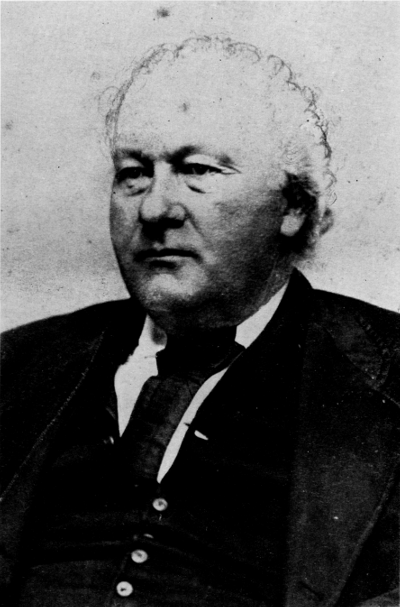
Figure 1.—Wendel Bollman, C.E. (1814-1884). (Photo courtesy of Dr. Stuart Christhilf.)
Robert M. Vogel
The development of structural engineering has always been as dependent upon the availability of materials as upon the expansion of theoretical concepts. Perhaps the greatest single step in the history of civil engineering was the introduction of iron as a primary structural material in the 19th century; it quickly released the bridge and the building from the confines of a technology based upon the limited strength of masonry and wood.
Wendel Bollman, self-taught Baltimore civil engineer, was the first to evolve a system of bridging in iron to be consistently used on an American railroad, becoming one of the pioneers who ushered in the modern period of structural engineering.
The Author: Robert M. Vogel is curator of civil engineering in the Smithsonian Institution’s Museum of History and Technology.
Wendel Bollman’s name survives today solely in association with the Bollman truss, and even in this respect is known only to a few older civil and railroad engineers. The Bollman system of trussing, along with those of Whipple and Fink, may be said to have introduced the great age of the metal bridge, and thus, directly, the modern period of civil engineering.
Bollman’s bridge truss, of which the first example was built in 1850, has the very significant distinction of being the first bridging system in the world employing iron in all of its principal structural members that was used consistently on a railroad.
The importance of the transition from wood to iron as a structural and bridge building material is generally recognized, but it may be well to mention certain aspects of this change.
The tradition of masonry bridge construction never attained the great strength in this country which it held in Europe, despite a number of notable exceptions. There were several reasons for this. From the very beginning of colonization, capital was scarce, a condition that prevailed until well into the 19th century and which prohibited the use of masonry because of the extremely high costs of labor and transport. An even more important economic consideration was the rapidity with which it was necessary to extend the construction of railways during their pioneer years. Unlike the early English and European railways, which invariably traversed areas of dense population and industrial activity, and were thus assured of a significant financial return almost from the moment that the first rail was down, the[Pg 80] Baltimore and Ohio and its contemporaries were launched upon an entirely different commercial prospect. Their principal business consisted not so much in along-the-line transactions as in haulage between principal terminals separated by great and largely desolate expanses. This meant that income was severely limited until the line was virtually complete from end to end, and it meant that commencement of return upon the initial investment was entirely dependent upon the speed of survey, graduation, tunneling, and bridging.

Figure 2.—Model of B. H. Latrobe’s truss, built in 1838, over the Patapsco River at Elysville (now Daniels), Maryland. (Photo courtesy of Baltimore and Ohio Railroad.)
The need for speed, the general attenuation of capital, and the simple fact that all the early railroads traversed thickly forested areas rendered wood the most logical material for bridge and other construction, both temporary and permanent.
The use of wood as a bridge material did not, of course, originate with the railroads, or, for that matter, in this country. The heavily wooded European countries—Switzerland in particular—had a strong tradition of bridge construction in timber from the Renaissance on, and naturally a certain amount of this technique found its way to the New World with the colonials and immigrants.
America’s highway system was meager until about the time the railroad age itself was beginning. However, by 1812 there were, along the eastern seaboard, a number of fine timber bridges of truly remarkable structural sophistication and workmanship.
It was just previous to the advent of the railroads that the erection of highway bridges in this country began to pass from an art to a science. And an art it had been in the hands of the group of skilled but unschooled master carpenters and masons who built largely from an intuitive sense of proportion, stress, and the general “fitness of things.” It passed into an exact science under the guidance of a small number of men trained at first in the scientific and technical schools of Europe, and, after about 1820, in the few institutions then established in America that offered technical instruction.
The increasing number of trained engineers at first affected highway bridge construction not so much in the materials used but in the way they were assembled. In a bridge designed by a self-taught constructor, the cheapness of wood made it entirely feasible to proportion the members by enlarging them to the point where there could be no question as to their structural adequacy. The trained engineer, on the other hand, could design from the standpoint of determining the entire load and then proportioning each element according to the increment of stress upon it and to the unit capacity of the material.
By the time railroads had started expanding to the West there had been sufficient experience with the half dozen practical timber truss systems by then evolved, that there was little difficulty in translating them into bridges capable of supporting the initial light rail traffic.
In spite of its inherent shortcomings, wood was so adaptable that it met almost perfectly the needs of the railroads during the early decades of their intense expansion, and, in fact, still finds limited use in the Northwest.
Wendel Bollman was born in Baltimore of German parents in 1814. His father was a baker, who in the same year had aided in the city’s defense against the[Pg 81] British. Wendel’s education, until about the age of 11, was more or less conventionally gained in public and private schools in Baltimore. He then entered into informal apprenticeship, first to an apothecary in Sheperdstown, Virginia (now West Virginia), and then to one in Harpers Ferry. In 1826 or 1827 he became ill and returned to Baltimore for cure. From that time on his education was entirely self-acquired.

Figure 3.—Trussed beam.
It is of interest, in light of his later career, to note that on the Fourth of July 1828, he marched with other boys in a procession that was part of the Baltimore and Ohio Railroad’s cornerstone-laying ceremony. Shortly afterward, he apprenticed himself to a carpenter for a brief time, but when the work slacked off he obtained work with the B. & O. The right-of-way had been graded for about five miles by that time, but no rail was down. The boy was at first given manual work, but soon advanced to rodman and rapidly rose as he gained facility with the surveying apparatus. In the fall of 1829 he participated in laying the first track. As his mother was anxious that he continue his education in carpentry, he left the railroad in the spring of 1830 to again enter apprenticeship. He finished, became a journeyman, helped build a planter’s mansion in Natchez, and returned to Baltimore in 1837 to commence his own carpentry business. The next year, while building a house in Harpers Ferry, he was asked to rejoin the B. & O. to rebuild parts of its large timber bridge over the Potomac there, which had fallen victim to various defects after about a year’s use.
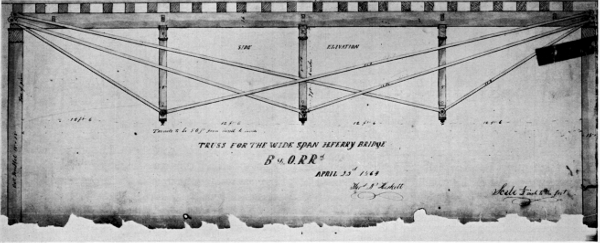
Figure 4.—Simple beam of 50-foot span with three independent trussing systems. Bollman’s use of this method of support led to the development of his bridge truss. This drawing is of a temporary span used after the timber bridge at Harpers Ferry was destroyed during the Civil War. (In Baltimore and Ohio Collection, Museum of History and Technology.)
Shortly after the Harpers Ferry bridge reconstruction, Bollman was made foreman of bridges. It is apparent that, on the basis of his practical ability,[Pg 82] enhanced by the theoretical knowledge gained by intense self-study, he eventually came to assist Chief Engineer Benjamin H. Latrobe in bridge design. He later took this work over entirely as Latrobe’s attentions and talents were demanded in the location and extension of the line between Cumberland and Wheeling.
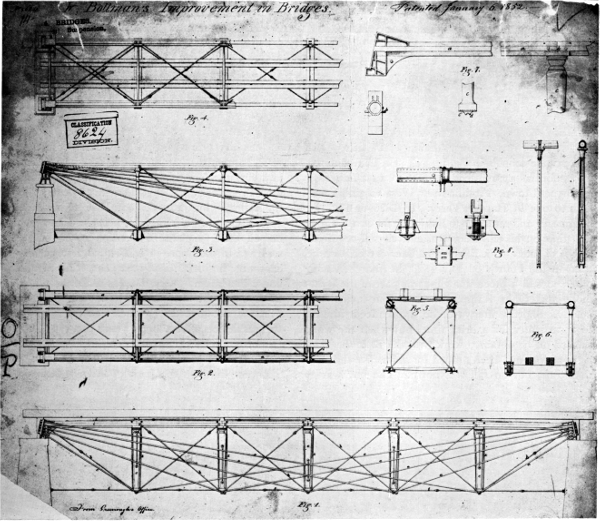
Figure 5.—Bollman’s original patent drawing, 1851. (In National Archives, Washington, D.C.)
The B. & O. did not reach its logical destination, Ohio (actually Wheeling, West Virginia, on the east bank of the Ohio River) until 1853. In the years following Bollman’s return to the railroad, the design of bridges was an occupation of the engineering staff second in importance only to the location of the line itself. During this time Bollman continued to rise and assume greater responsibilities, being appointed master of road by Latrobe in 1848. In this position he was responsible for all railroad property that did not move, principally the right-of-way and its structures, including, of course, bridges.
The recognition of Bollman’s abilities was in the well-established tradition of the B. & O., long known as America’s first “school of engineering,” having sponsored many early experiments in motive power, trackwork, and other fundamental elements of railroad[Pg 83] engineering. It furnished the means of expression for such men as Knight, Wright, Whistler, Latrobe, and Winans.
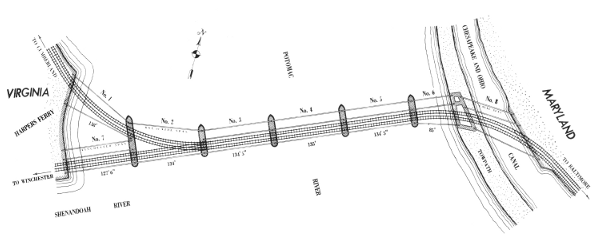
Figure 6.—Plan of Harpers Ferry bridge as built by Latrobe. The second Winchester track was later removed.
Of these pioneer civil and mechanical engineers, some were formally trained but most were self-taught. Bollman’s career on the B. & O. is of particular interest not only because he was perhaps the most successful of the latter class but because he was probably also the last. He may be said to be a true representative of the transitional period between intuitive and exact engineering. Actually, his designing was a composite of the two methods. While making consistent use of mathematical analysis, he was at the same time more or less dependent upon empirical methods. For years, B. & O. employees told stories of his sessions in the tin shop of the railroad’s main repair facility at Mount Clair in Baltimore, where he built models of bridges from scraps of metal and then tested them to destruction to locate weaknesses. It seems most likely, however, that the empirical studies were used solely as checks against the mathematical.

Figure 7.—Recent model of Bollman’s Winchester span. Only two of the three lines of trussing are shown. The model is based on Bollman’s published description and drawings of the structure. (USNM 318171; Smithsonian photo 46941.)
In the period when Bollman began designing—about 1840—there were fewer than ten men in the country designing bridges by scientifically correct analytical methods, Whipple and Roebling the most notable of this group. By 1884, the year of Bollman’s death,[Pg 84] the age of intuitive design had been dead for a decade or longer.
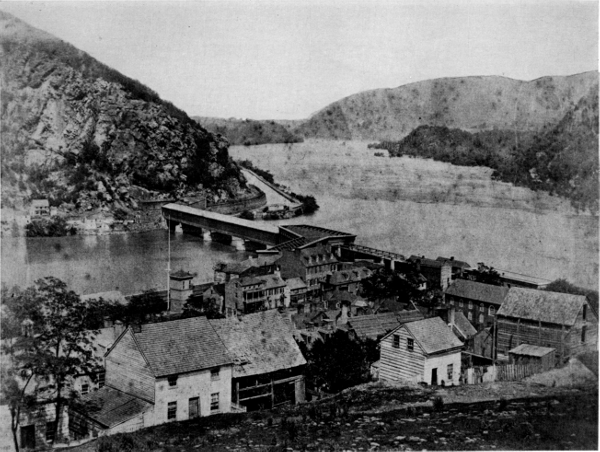
Figure 8.—The Baltimore and Ohio Railroad’s Potomac River crossing at Harpers Ferry, about 1860. Bollman’s iron “Winchester span” of 1851 is seen at the right end of Latrobe’s timber structure of 1836, which forms the body of the bridge. (Photo courtesy of Harpers Ferry National Historical Park.)
The B. & O. was in every way a truly pioneer enterprise. It was the first practical railroad in America; the first to use an American locomotive; the first to cross the Alleghenies. The spirit of innovation had been encouraged by the railroad’s directors from the outset. It could hardly have been otherwise in light of the project’s elemental daring.
The first few major bridges beyond the line’s starting point on Pratt Street, in Baltimore, were of rather elaborate masonry, but this may be explained by the projectors’ consciousness of the railroad’s significance and their desire for permanence. However, the aforementioned economic factors shortly made obvious the necessity of departure from this system, and wood was thereafter employed for most long spans on the line as far as Harpers Ferry and beyond. Only the most minor culverts and short spans, and those only in locations near suitable quarries, were built of stone.
In addition to the economic considerations which prompted the company to revert to timber for the major bridges, there were several situations in which masonry construction was unsuitable for practical reasons. If stone arches were used in locations where the grade of the line was a relatively short distance above the surface of the stream to be crossed, a number of short arches would have been necessary to avoid a very flat single arch. In arch construction,[Pg 85] the smaller the segment of a circle represented by the arch (that is, the flatter the arch), the greater the stress in the arch ring and the resulting horizontal thrust on the abutments.
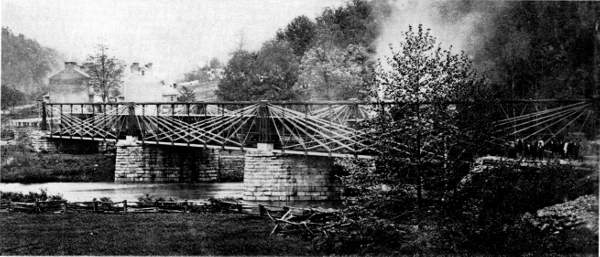
Figure 9.—Bollman skew bridge at Elysville (now Daniels), Maryland, built in 1853-1854. (Photo courtesy of Maryland Historical Society.)
The piers for the numerous arches necessary to permit an optimum amount of rise relative to the span would have presented a dangerous restriction to stream flow in time of flood. By the use of timber trusses such crossings could be made in one or two spans with, at the most, one pier in the stream, thus avoiding the problem.
The principal timber bridges as far west as Cumberland were of Latrobe’s design. These were good, solid structures of composite construction, in which a certain amount of cast iron was used in joints and wrought iron for certain tension members. They were, however, more empirical than efficient and, for the most part, not only grossly overdesigned but of decidedly difficult fabrication and construction.
What is interesting about the Latrobian timber trusses, however, is the effect they appear to have had upon Bollman’s subsequent work in the design of his own truss. This effect is evidenced by the marked analogy between the primary structural elements of the two types. The Latrobe truss at Elysville (fig. 2) was only partially a truss, inasmuch as the greater part of the load was not carried from panel to panel, finally to appear at the abutments as a pure vertical reaction, but was carried from each panel (except the four at the center) directly to the bearing points at the piers by heavy diagonal struts, after the fashion of the famous 18th-century Swiss trusses of the Grubenmanns. It was a legitimate structural device, and the simplest means of extending the capacity of a spanning system. However, it was defective in that the struts applied considerable horizontal thrust to the abutments, requiring heavier masonry than would otherwise have been necessary.
It is quite likely that Latrobe did not have absolute confidence in the various pure truss systems already patented by Town, Long, and others, and preferred for such strategic service a structure in which the panel members acted more or less independently of one another. It will be seen that, similarly, the individual panel loads in Bollman’s truss were carried to the ends of the frame by members acting independently of one another.
There had never been any question about the many serious inadequacies of wood as a bridge material. Decay and fire risk, always present, were the principal ones, involving continuous expenditure for replacement of defective members and for fire watches. It was, in fact, understood by the management and engineering staff of the B. & O. that their timber bridge superstructures, though considered the finest in the country, were more or less expedient and were eventually to be replaced. In this regard it is not surprising that Latrobe, a man of considerable foresight, had, at an early date, given serious thought to the possible application of iron here.
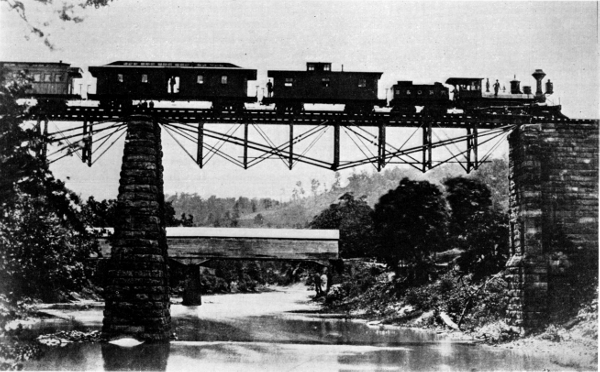
Figure 10.—Potomac River crossing of the Baltimore and Ohio at North Branch, Maryland, built in 1856. There are three Bollman deck trusses. (Photo courtesy of Baltimore and Ohio Railroad.)
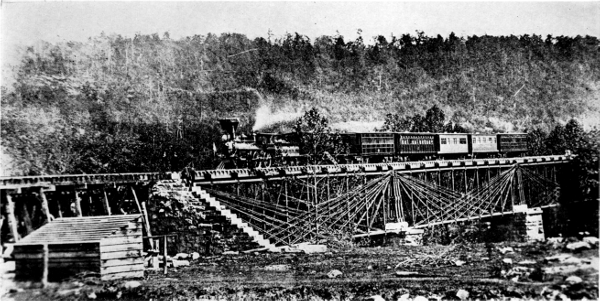
Figure 11.—The Fink truss. (Smithsonian photo 41436.)
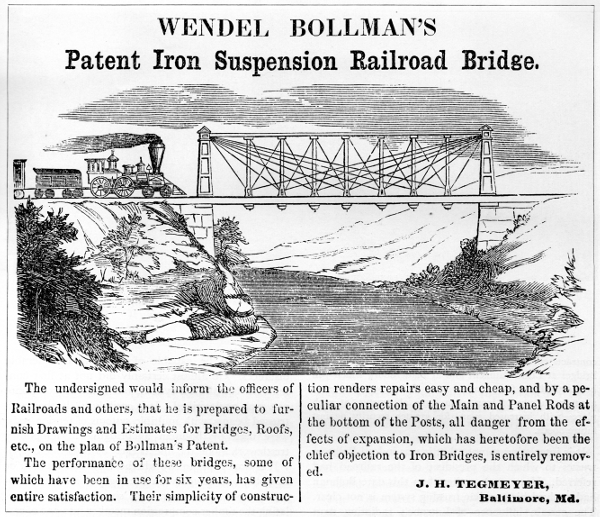
Figure 12.—Advertisement in the Railroad Advocate, August 1855.
The world’s first major iron bridge, the famed cast-iron arch at Coalbrookdale, England, had been constructed in 1779. Its erection was followed by rather sporadic interest in this use of the material. The first significant use of iron in this country was in a series of small trussed highway arches erected by Squire Whipple over the Erie Canal in the early 1840’s, over 60 years later. In these, as in most of the earlier iron structures, an arch of cast iron was the primary support. The thrust of the arches was counteracted by open wrought-iron links with other wrought- and cast-iron members contributing to the truss action.
The Whipple bridges promoted a certain amount of interest in the material. In the B. & O.’s annual report for the fiscal year 1849 appears the first record of Latrobe’s interest in this important matter. In the president’s message is found the following, rather offhand, statement:
$6,183.19 have been expended toward the renewal of the Stone Bridges on the Washington Branch, carried off by the flood of Oct. 7th, 1847. Preparations are made and[Pg 88] contracts entered into, for the reconstruction of the large Bridges at Little Patuxent and at Bladensburg which will be executed in a few months.... It is proposed to erect a superstructure of Iron upon stone abutments, at each place—with increased span, for greater security against future floods.
It is interesting to note that it was indeed Bollman trusses to which the president of the railroad had referred. How much earlier than this date Bollman had evolved his peculiar trussing system is not clear. The certain influence of Latrobe’s radiating strut system of trussing has been mentioned. As likely an influence was another basic technique commonly used to increase the capacity of a simple timber beam—that of trussing—i.e., placing beneath the beam a rod of iron that was anchored at the ends of the beam and held a certain distance below it at the center by a vertical strut or post. This combination thus became a truss in that the timber portion was no longer subject to a bending stress but to a simple one of compression, the rod absorbing the tensile stress of the combination. The effect was to deepen the beam, increasing the distance between its extreme fibers and—by thus reducing the bending moment—reducing the stress in them (see fig. 3).
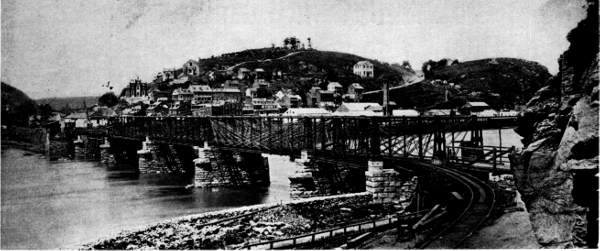
Figure 13.—The four Bollman spans at Harpers Ferry that survived the Civil War. The spans were completed in 1862-1863. (Photo courtesy of Baltimore and Ohio Railroad.)
It apparently occurred to Bollman that by extending the number of rods in a longitudinal direction, this effect could be practically amplified to such an extent as to be capable of spanning considerable distances. He almost certainly did not at first contemplate an all-iron system, but rather a composite one such as described. It is entirely likely that such trussed beams, with multiple systems of tension rods, were used by Bollman as bridging in temporary trestlework along the line as early as 1845 (see fig. 4).
It is impossible to say whether Bollman himself, or Latrobe, was struck with the logic of further elaborating upon the system and, simultaneously, translating the timber compression member into one of cast iron. Cast iron would naturally have been selected for a member that resisted a compressive stress, as it was considerably cheaper than wrought iron. But more important, at that time wrought iron was not available in shapes of sufficient sectional area to resist the appreciable buckling stresses induced in long compression members. The cost of building up members to sufficient size from the very limited selection of small shapes then rolled would have been prohibitive.
The trussing rods, subjected to tension, were of wrought iron inasmuch as the sectional area had only to be sufficient to resist the primary axial stress.
The first all-iron Bollman truss was constructed over the Little Patuxent River at Savage Factory, near Laurel, Maryland, in 1850. In the chief engineer’s report for the year 1850, Latrobe was able to state that the truss had been completed and was giving[Pg 89] “much satisfaction.” He went on at some length to praise the “valuable mechanical features” embodied therein, and expressed great confidence that iron would become as important a material in the field of civil engineering as it was in mechanical engineering.
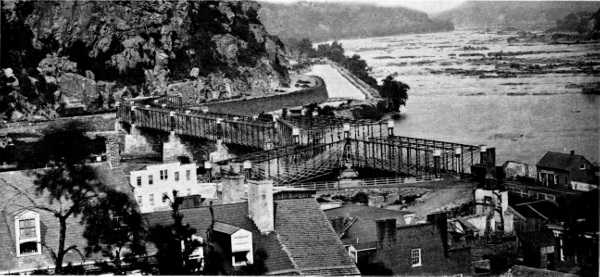
Figure 14.—The Harpers Ferry bridge as completed after the Civil War. It was used by the Baltimore and Ohio until 1894, and as a highway bridge until 1936. (Photo 690, Baltimore and Ohio Collection, Museum of History and Technology.)
The cost of this first major Bollman bridge was $23,825.00. Its span was 76 feet. Latrobe’s confidence was well placed. The Savage span and another at Bladensburg may be considered successful pilot models, for, in spite of a certain undercurrent of mistrust of iron bridges within the engineering profession—due mainly to a number of failures of improperly designed spans—Latrobe felt there was sufficient justification for the unqualified adoption of iron in all subsequent major bridge structures on the B. & O.
Almost immediately following completion of the Savage Bridge, Bollman undertook the design of replacements for the large Patapsco River span at Elysville (now Daniels), Maryland, and the so-called Winchester span of the B. & O.’s largest and most important bridge, that over the Potomac at Harpers Ferry. Harpers Ferry bridge, a timber structure, had been designed by Latrobe and built in 1836-1837 by the noted bridge constructor Lewis Wernwag. It was peculiar in having a turnout, near the Virginia shore, whereby a subsidiary road branched off to Winchester (see fig. 6). Only the single span on this line, situated between the midriver switch and the shore, was slated for replacement, as the other seven spans of the bridge had been virtually reconstructed in the decade or so of their history and were in sound condition at the time.
The Winchester span (fig. 8), which was the first Bollman truss to embody sufficient refinement of detail to be considered a prototype, was completed in 1851. Bollman was extremely proud of the work, with perfect justification it may be said. The 124-foot span was fabricated in the railroad’s extensive Mount Clair shops. It was subdivided into eight panels by seven struts and seven pairs of truss rods. An interesting difference between this span and Bollman’s succeeding bridges was his use of granite rather than cast iron for the towers. The span consisted of three parallel lines of trussing to accommodate a common road in addition to the single-track Winchester line.
The distinctive feature of the Bollman system was the previously mentioned series of diagonal truss links in combination with a cast-iron compression chord, which Bollman called the “stretcher.” The spacing between the chord and the junction of each pair of[Pg 90] links was maintained by a vertical post or strut, also cast.
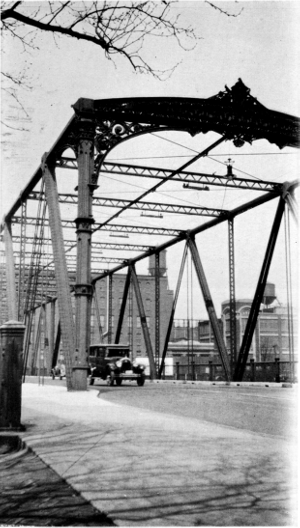
Figure 15.—North Street (now Guilford Avenue) bridge, Baltimore. In this transitional composite structure cast iron was used only in the relatively short sections of the upper chord. For the long unsupported compression members of the web system, standard wrought-iron angles and channels were built up into a large section. The decorative cast-iron end posts were non-structural. (Photo in the L. N. Edwards Collection, Museum of History and Technology.)
Much of the appeal of this design lay unquestionably in the sense of security derived from the fact that each of the systems acted independently to carry its load to the abutments. The lower chords, actually nonfunctional in the primary structure, were included merely to preserve the proper longitudinal spacing between the lower ends of the struts. A certain lack of rigidity was inherent in the system due to that very discontinuity which characterized its action; however, this was compensated for by a pair of light diagonal stay rods crossing each panel. These rods served the additional function of distributing concentrated loads to adjacent struts much in the manner of the bridging between floor joists in a building.
In the Winchester span the floor system was of timber for reasons of economy. This was a very minor weakness inasmuch as any stick could be quickly replaced, and without disturbing the function of the structure. Bollman received a patent for his truss in January 1852, and in the same year published a booklet describing his system in general and the Harpers Ferry span in particular. Here, he first calls it a “suspension and trussed bridge,” which is indeed an accurate designation for a system which is not strictly a truss because it has no active lower chord. (The analogy to a suspension bridge is quite clear, each pair of primary rods being comparable to a suspension cable.) Thereafter, Bollman’s invention was generally termed a suspension truss.
Bollman’s 1852 publication was widely disseminated here and abroad and studied with respectful interest by the engineering profession. Its drawings of the structure were copied in a number of leading technical journals in England and Germany. Although there is no record that the type was ever reproduced in Europe, there can be little doubt that this successful structural use of iron by the most eminent railroad in the United States and its endorsement by an engineer of Latrobe’s status gave great impetus to the general adoption of the material. This influence was certainly equal to that of Stephenson’s tubular iron bridge of 1850 over the Menai Strait, or Roebling’s iron-wire suspension bridge of 1855 over Niagara gorge. The Bollman design had perhaps even greater influence, as the B. & O. immediately launched the system with great energy and in great numbers to replace its timber spans; on the other hand, Roebling’s structure was never duplicated in railroad service, and Stephenson’s only once.[Pg 91]
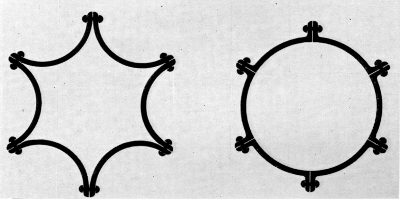
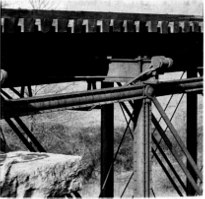
Figure 16.—Left: conjectural section of Bollman’s segmental wrought-iron column, about 1860, and section of the standard Phoenix column; right: Phoenix column as used in truss-bridge compression members.
By the late 1850’s iron was well established as a bridge material throughout the world. Once the previous fears of iron had been stilled and the attention of engineers was directed to the interpretation of existing and new spanning methods into metal, the Bollman truss began to suffer somewhat from the comparison. Although its components were simple to fabricate and its analysis and design were straightforward, it was less economical of material than the more conventional panel trusses such as the Pratt and Whipple types. Additionally, there was the requisite amount of secondary metal in lower chords and braces necessary for stability and rigidity.
A factor difficult to assess is Bollman’s handling of his patent, which was renewed in 1866. There is sufficient evidence to conclude that he considered the patent valuable because it was based upon a sound design. Therefore, he probably established a high license fee which, with the truss’s other shortcomings, was sufficient to discourage its use by other railroads. As patron, the B. & O. had naturally had full rights to its use.
An additional defect, acknowledged even by Bollman, arose because of the unequal length of the links in each group except the center one. This caused an unevenness in the thermal expansion and contraction of the framework, with the result that the bridges were difficult to keep in adjustment. This had the practical effect of virtually limiting the system to intermediate span lengths, up to about 150 feet. For longer spans the B. & O. employed the truss of another of Latrobe’s assistants, German-born and technically trained Albert Fink.
The Fink truss was evolved contemporaneously with Bollman’s and was structurally quite similar, being a suspension truss with no lower chord. The principal difference was the symmetry of Fink’s plan, which was achieved by carrying the individual panel loads from the panel points to increasingly longer panel units before having them appear at the end bearings. This eliminated the weakness of unequal strains. The design was basically a more rational one, and it came to be widely used in spans of up to 250 feet, generally as a deck-type truss (see fig. 11).
Bollman resigned from the Baltimore and Ohio in 1858 to form, with John H. Tegmeyer and John Clark, two of his former B. & O. assistants, a bridge-building firm in Baltimore known as W. Bollman and Company. This was apparently the first organization in the United States to design, fabricate, and erect iron bridges and structures, pioneering in what 25 years later had become an immense industry. The firm had its foundation at least as early as 1855 when advertisements to supply designs and estimates for Bollman bridges appeared over Tegmeyer’s name in several railroad journals (see fig. 12).
Bollman’s separation from the B. & O. was not a complete one. The railroad continued its program of replacing timber bridges with Bollman trusses, and contracted with W. Bollman and Company for design[Pg 92] and a certain amount of fabrication. There is some likelihood that eventually fabrication was entirely discontinued at Mount Clair, and all parts subsequently purchased from Bollman.
The firm prospered, erecting a number of major railroad bridges in Mexico, Cuba, and Chile. Operations ceased from 1861 to 1863 because of difficult wartime conditions in the border city of Baltimore. Following this, Bollman reentered business as sole proprietor of the Patapsco Bridge and Iron Works.

Figure 17.—Chicago, Burlington and Quincy Railroad bridge over Quincy Bay (branch of the Mississippi River) at Quincy, Illinois. The pivot draw-span was formed of two Bollman deck trusses supported at their outer ends by hog chains. The bridge was built in 1867-1868 by the Detroit Bridge and Iron Co., Bollman licensee. (Clarke, Account of the Iron Railway Bridge ... at Quincy, Illinois.)
The most noteworthy of Bollman’s works in this period was a series of spans at Harpers Ferry. The B. & O.’s timber bridge had been destroyed by Confederate forces in June 1861, and the crossing was thereafter made upon temporary trestlework. This was a constant source of trouble, with continuing interruptions of the connection from high water, washouts, and military actions. The annoyance and expense of this became so great that the company decided to risk an iron bridge at the crossing. In July and August 1862, two sections of Bollman truss, spans no. 4 and no. 5 were completed. As this occurred during the time when W. Bollman and Company was inoperative, the work was produced at Mount Clair to Bollman’s design and, undoubtedly, erected under his supervision. Five weeks later, on September 24, these and Bollman’s famous Winchester span of 1851 were blown up by the Confederates, and the line’s business was again placed at the mercy of trestling.
The spirit of the B. & O. administration indeed seems to have been unshakable when, in the face of such heartbreaking setbacks, it determined to again bridge the river with iron, even at the height of the hostilities. In November, span no. 5 was erected, and by April 1863 nos. 3, 4, and 6 also. These were the four straight spans in midriver between the “wide” (or “branch,” or “wye”) span and the span on the Maryland shore over the Chesapeake and Ohio Canal (see fig. 13). Although the wood floor system of these spans was burned for strategic reasons by U.S. troops later in 1863, they survived the war.
In 1868 the remaining trestlework was replaced with Bollman trusses. This magnificent structure served the railroad until 1894 when the right-of-way was realigned at Harpers Ferry. However, the half used by the common road remained in use until carried away by the disastrous flood in 1936. The piers may still be seen.
During the prewar years, Bollman evolved a structural development of most profound importance, which is usually associated with the Phoenix Iron Works and its founder, Samuel J. Reeves. In the erection of a high trestlework viaduct for the Havana Railroad, Bollman apparently became concerned with the tensile weakness of cast iron when applied in long, unsupported columns. Although a column is normally subjected to compressive stresses, when the slenderness ratio—that is, the length divided by the radius of gyration of the cross section—becomes great, a secondary bending stress may be produced. If this stress becomes great enough, the value of the tensile stress in one side of the column may actually exceed the principal compressive stress, and a net effect of tension result.[Pg 93]
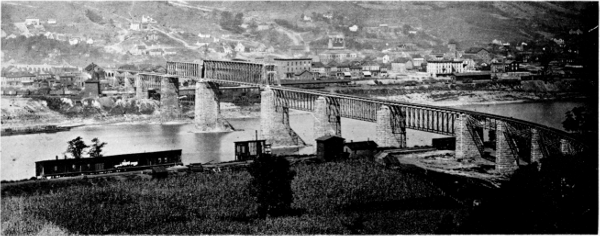
Figure 18.—Ohio River crossing of the Baltimore and Ohio at Benwood, West Virginia, completed in 1870. Bollman deck trusses were used in the approaches on both sides. (Photo 693, Baltimore and Ohio Collection, Museum of History and Technology.)
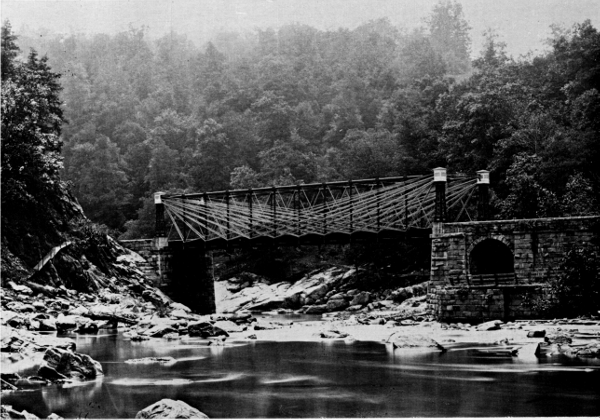
Figure 19.—Patapsco River crossing of the Baltimore and Ohio between Thistle and Ilchester, Maryland. (Photo 695, Baltimore and Ohio Collection, Museum of History and Technology.)
As already mentioned, the few available rolled-iron shapes were of relatively small area and quite unsuitable for use as columns unless combined and built up in complex fabrications. The normal practice at the time was to use cast compression members in iron bridges and structures, with their sectional area so proportioned to the length that a state of tension could not exist. In the case of long members, this naturally meant that an excessive amount of material was used.
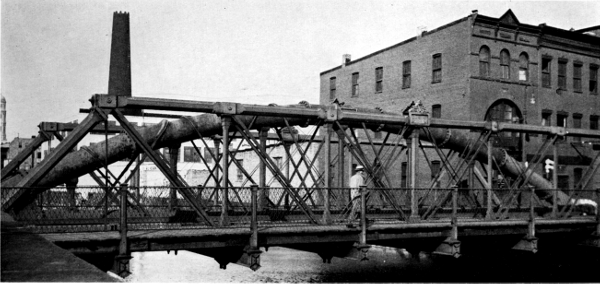
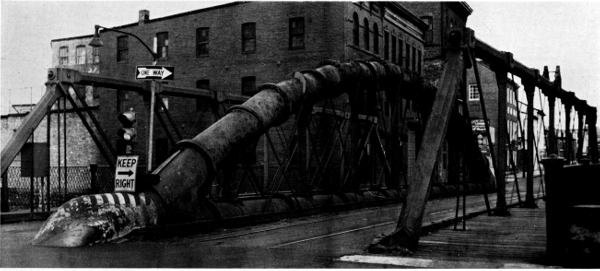
Figure 20.—Two views of Bollman-built “water-pipe truss” that carries Lombard Street over Jones Falls in Baltimore. Built in 1877.
Bollman was conscious of the problem from his experience with the stretchers and struts of his truss, and he must have been aware of the great advantage which would be obtained by a practical method of forming such members in wrought iron, the tensile resistance of which is equivalent to the compressive. He eventually developed the forerunner of what came to be known as the Phoenix form by having special segmental wrought-iron shapes rolled by Morris, Tasker and Company of Philadelphia, these shapes being combined into a circular section with out[Pg 95]standing flanges for riveting together. The circular section is theoretically the most efficient to bear compressive loading. A column of any required diameter could be produced by simply increasing the number of segments, the individual size of which never exceeded contemporary rolling mill capacity (see fig. 16).
The design exhibits the inspired combination of functional perfection and simplicity that seems to characterize most great inventions.
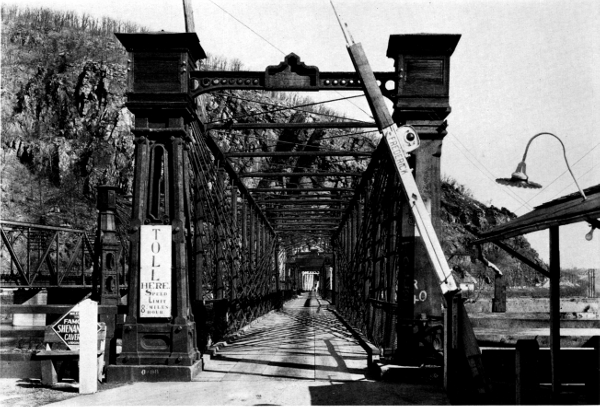
Figure 21.—The Harpers Ferry bridge toward the end of its career, carrying a common road over the Potomac. The westernmost line of trussing and span no. 1 had been removed long before. View through the Winchester span looking toward Maryland in 1933. (Photo courtesy of Harpers Ferry National Historical Park.)
It may have been because he had no facilities for rolling that Bollman communicated his idea to Reeves, although this seems illogical. At any rate, Reeves and his associates patented the system extensively, and the Phoenix column was eventually employed to the virtual exclusion of cast-iron and other types of wrought-iron columns. By the end of the 19th century it began to pass from use, as mills became capable of producing larger sections with properties relatively favorable to column use and more adaptable to connection with other members.
The Bollman truss found occasional use elsewhere than on the B. & O. lines, but generally only when erected on contract by Patapsco Bridge and Iron Works. However, the fact that Bollman could profitably erect this bridge in the severely competitive 1870’s indicates that the harsh criticism of the system by authorities of such stature as Whipple was not necessarily justified. Bollman’s advertisements, in fact, refer to the favorable recommendations of other[Pg 96] such renowned engineers as Herman Haupt and M. C. Meigs.
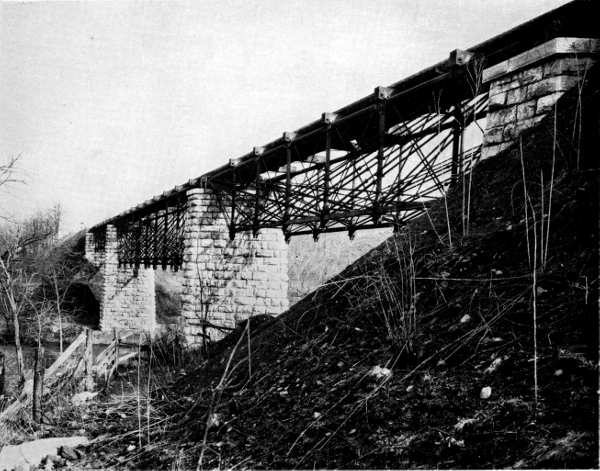
Figure 22.—Bollman deck trusses in the North River Bridge built in 1873 at Mount Crawford, Virginia, on the Valley Railroad of Virginia (B. & O.). Each end span is 98 ft. 6 in.; the river span is 148 ft. 9 in. (Photo 756, Baltimore and Ohio Collection, Museum of History and Technology.)
An interesting application of the system was in a drawbridge, formed of two Bollman deck spans, over an arm of the Mississippi at Quincy, Illinois (see fig. 17). The first iron bridge in Mexico was erected by Bollman over the Medellín River about 1864. Another work of this period, which attracted considerable attention, was a pair of bridges that Bollman erected over North Carolina’s Cape Fear River in 1867-1868. These bridges were notable for their foundation on cast-iron cylinders, sunk pneumatically. This was one of the first instances of the use of the process in America, and the depth of 80 feet below the water surface reached by one cylinder was considered remarkable for years afterward.
In the last active decade or so of his career, Bollman produced hundreds of minor bridges and other structures. In 1873 he supplied the castings for the splendid iron dome of Baltimore’s City Hall and erected the ingenious water-main truss which carries Lombard Street over Jones Falls in that city. In this structure the top and bottom chords of the central line of trussing are cast-iron water mains, bifurcated at the abutments, and joined by cast- and wrought-iron web members (see fig. 20).[Pg 97]
In the mid 1870’s Bollman saw his truss pass into obsolescence. This was due primarily to the generally increasing distrust of cast iron for major structural members due to its brittleness, but advances in structural theory, availability of a greater variety of rolled structural shapes, and the increasing loading patterns of the period all contributed.
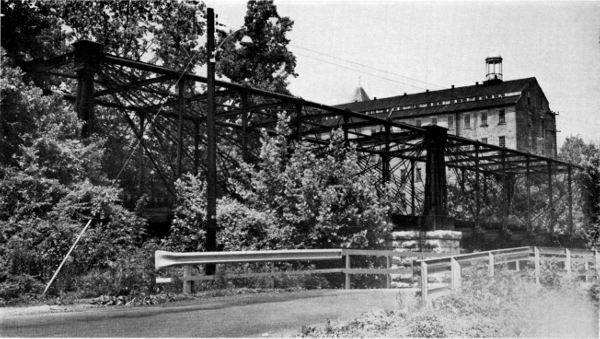
Figure 23.—The only surviving Bollman truss bridge, at Savage, Maryland. The bridge was built elsewhere in 1852 and was moved to this now-abandoned Baltimore and Ohio industrial siding in about 1888.
Although no Bollman trusses were built by Bollman or the B. & O. after 1875, those in use were only removed as required by heavier motive power. The Harpers Ferry span, as noted, remained in full main-line service until 1894. Bollman trusses on feeder lines were continued in use until much later; a number of them on the Valley Railroad of Virginia (see fig. 22) were not removed until 1923. However, only on the most isolated spurs was the Bollman truss permitted to reach really ripe age. The sole known remaining example (fig. 23) stands on such a branch—ironically, at Savage, over the Little Patuxent, the site of the first Bollman span. This is not the 1850 bridge, but one built in 1852 and moved to the present site 30 years later. The fate of the first span is not known.[Pg 98]
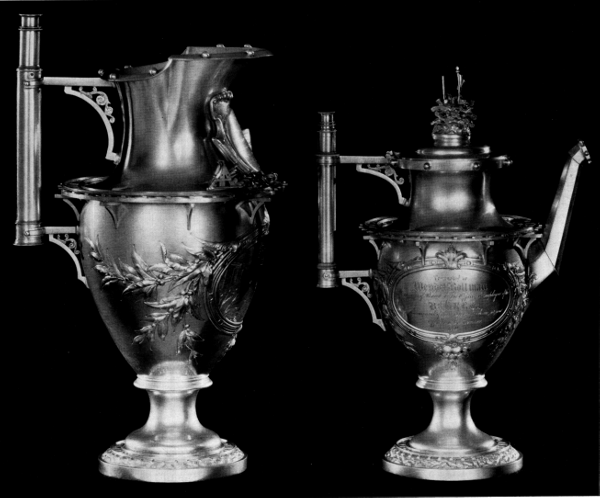
Figure 24.—Hot-water and chocolate pitchers of the 10-piece, silver tea service presented to Bollman by his fellow employees when he resigned from the Baltimore and Ohio in 1858. A railroad motif was used throughout, each piece being circled at top and bottom by a track, complete with rail of accurate section and ties. Spouts are in simulation of hexagonal sheet-iron chimneys, with seams riveted, and the handles are in the form of a surveyor’s telescope. On the various pieces are engraved the designs of the more important B. & O. bridges. Throughout is a wonderful profusion of bits and objects of railroadiana in low relief, high relief, and fully modeled. In Board of Directors Room, Baltimore and Ohio Railroad Company, Baltimore, Md. (Photo courtesy of Baltimore and Ohio Railroad.)
(All B. & O. works listed were designed by Bollman and built by the railroad, unless otherwise indicated.)
| Dates of service | Location | Type | No. spans / length of each | Remarks |
| 1850-? | Savage, Md., Little Patuxent River | Bollman through truss | 1/76' | First Bollman truss erected; granite towers; cost, $23,825. B. & O. RR. |
| 1851-? | Bladensburg, Md., Anacostia River | Bollman through truss | 1/? | Second Bollman truss erected; granite towers; cost, $19,430. B. & O. RR. |
| 1851-1862 | Harpers Ferry, Va., Potomac River | Bollman through truss | 1/124' | Winchester span; first major Bollman truss; three lines of truss; granite towers; blown up by Confederate Army on September 24, 1862. B. & O. RR. |
| 1851-? | Baltimore, Md., Carey Street | Trestle | — | Wood trestle bents with wrought-iron diagonals. First use of iron structural members in trestlework. Total length 76 feet. B. & O. RR. |
| 1852- | Savage, Md., Little Patuxent River | Bollman through truss | 2/?80' | Still standing. Moved to Savage in 1888; original location unknown. This and succeeding Bollman trusses use iron towers. B. & O. RR. |
| 1852 (or 1853)-? | Marriottsville, Md., Patapsco River | Bollman truss | 1/50' | One of first Bollman trusses with iron towers. B. & O. RR. |
| 1853-? | Zanesville, Ohio, Muskingum River | Bollman truss | 4/124' (or 5/160') | Double track, Central Ohio RR. Designed by Bollman; built by Douglas, Smith & Co., Zanesville. |
| 1854-1870(?) | Elysville (now Daniels), Md., Patapsco River | Bollman through truss | 3/97'9" | Upper bridge, skew. Cost, $24,477.59. B. & O. RR. |
| 1854-1862 | Monocacy, Md., Monocacy River | Bollman truss | 3/119' | Blown up September 8, 1862; rebuilt in 1864. Cost, $22,722.59. B. & O. RR. |
| 1854-? | Eastern Ohio | Bollman truss(?) | 1/40' | C. O. RR. Section 76 adjacent to 300-ft. tunnel. |
| 1855-? | Bridgeville, Ohio, Salt Creek | Bollman deck truss | 1/71' | C. O. RR. |
| Pre-1855-? | Buffalo, N.Y. | — | — | Unidentified. Mentioned by George Vose in Railroad Advocate (June 9, 1855). |
| 1856-? | Elysville, Md., about 1-1/4 miles east of 1854 bridge, Patapsco River | Bollman through truss | 3/111' | Lower Bridge. B. & O. RR. |
| [Pg 100]Pre-1856-? | Marriottsville, Md. | Bollman truss(?) | 1/48'9" | Referred to as “Tunnel Bridge” in B. & O. RR. annual report, 1856. |
| 1856-? | Near Ijamsville, Md., Bush Creek | Iron girders | 3/23'9" | Possibly trussed beams; mentioned in B. & O. RR. annual report, 1856. |
| 1856-? | Near Ijamsville, Md., Bush Creek | Iron girders | 2/23'9" | As above. |
| 1856-c.1862 | North Branch, Md., Potomac River | Bollman deck truss | 3/142' | Partially destroyed in Civil War. B. & O. RR. |
| 1860-1906 | Chile, Angostura River | Bollman truss(?) | 4/115' | Chilean Railways. Designed and built by Bollman. Replaced by bridge built by French firm of Schneider, Cruesot & Co. |
| 1860-1910 | Chile, Paine River | Bollman truss(?) | 1/? | As above. |
| Post-1860-? | Ilchester, Md., Patapsco River | Bollman through truss | 1/? | B. & O. RR. |
| Pre-1861-? | Cuba | Bridges and station house | — | All bridges on Havana RR., including iron station house and bridge at Guines. Designed and built by Bollman. |
| Pre-1861-? | Cuba | Bridges | — | All bridges on Cienfuegos RR., Cárdenas RR., and Havana & Matanzas RR. Designed and built by Bollman. |
| Pre-1861-? | Cuba | Trestle | — | Trestle with wrought-iron columns (the first such ever constructed). Havana RR. Designed and built by Bollman. |
| 1862-1862 | Harpers Ferry, Va., Potomac River | Bollman through truss | 2/160' | Span no. 3 (July 24) and span no. 4 (August 21). Blown up September 24, 1862. B. & O. RR. |
| 1862-1936 | Harpers Ferry, Va., Potomac River | Bollman through truss | 1/160' | Span no. 5 (November). B. & O. RR. |
| 1863-1936 | Harpers Ferry, Va., Potomac River | Bollman through truss | 3/160' | Spans nos. 3, 4, and 5. Constructed previous to April 1863. B. & O. RR. |
| 1863-? | Berwyn, Md., Paint Branch | Bollman truss(?) | ? | Iron bridge mentioned in B. & O. RR. annual report, 1863 |
| 1863(4?)-? | Clinton, Iowa, Mississippi River | Pivot draw | 1/360' | Built by Detroit Bridge & Iron Works. It was the longest in the world at time of completion. Designed by Bollman. |
| 1864-? | [Pg 101]Laurel, Md., Patuxent River | Bollman truss | ? | Replaced stone arch that had been washed out. B. & O. RR. |
| c. 1864-? | Near Veracruz, Mexico, Medellín River | Bollman hrough truss | 1/115' | Veracruz & Jucaro RR. First iron bridge in Mexico. Designed and built by Bollman. |
| 1864-? | Near Point of Rocks, Md., Back Creek | Bollman truss(?) | 1/80'(?) | Iron bridge mentioned in B. & O. RR. annual report, 1864. The span length given is that of previous stone arch. |
| 1864-? | Bladensburg, Md., Anacostia River | Bollman truss | 1/? | Span for second track, to match 1851 span. B. & O. RR. |
| 1868-? | Cape Fear, N.C., Northeast Branch, Cape Fear River | Bollman truss(?) | 2/146'6" 1/164' pivot draw/150' | Wilmington Railway Bridge Co. This bridge was connected to that over the Northwest Branch by 2-1/2 miles of timber trestling. Designed and built by Bollman. |
| 1868-? | Cape Fear, N.C., Northwest Branch, Cape Fear River | Bollman truss(?) | 1/217'(?) pivot draw/150' | See above. |
| 1868-? | Quincy, Ill., Quincy Bay (in Mississippi River) | Bollman deck truss | 4/85' pivot draw/190' | Chicago, Burlington & Quincy RR. The pivot draw was formed of two 85-ft. simple Bollman deck spans whose outer ends hung from hog chains. Designed by Bollman; built by Detroit Bridge & Iron Works. |
| 1869-c.1892 | Baltimore, Md., over Jones Falls, B. & O. RR., and Northern Central RR. | Warren truss | 2/100' 2/55'6" | North Avenue Bridge. Composite double intersection truss; timber top chord and posts, wrought-iron lower chord and ties. In 55-ft. spans, both chords timber. Cost, $73,588. Built by Bollman. |
| c.1869-1936 | Harpers Ferry, Va., Potomac River | Bollman through truss | 4/? | Canal span (no. 8), Wide span (no. 2), Winchester span, and West End span. Destroyed by flood in 1936. B. & O. RR. |
| 1870-.1895 | Baltimore, Md., Jones Falls | Iron “Isometrical truss” (probably Pratt type) | 1/108' | Charles Street Bridge. Three lines of trussing.Cost, $20,297. Built by Bollman. |
| 1870-1893 & 1900 | Bellaire, Ohio-Benwood W. Va., Ohio River | Bollman deck truss | 9/107'-125' | In approaches; 2 spans on Ohio side; 7 on West Virginia side. B. & O. RR. |
| 1870-c.1895 | [Pg 102]Belpre, Ohio-Parkersburg, W. Va., Ohio River | Bollman deck truss | 16/? | In approaches; 7 spans on Ohio side; 9 on West Virginia side. B. & O. RR. |
| 1870-? | Elysville, Md., Patapsco River | Bollman through truss | 4/? | Skew; replacement of Upper Bridge(?). B. & O. RR. |
| 1871-c.1895 | Baltimore, Md., Jones Falls | Timber and iron truss | ? | Decker Street (now Maryland Avenue) Bridge. Cost, $24,975. Built by Bollman. |
| 1871-c.1892 | Baltimore, Md., over Northern Central RR. at Jones Falls | Warren truss | 1/100' | North Avenue Bridge. Composite double intersection truss; cast-iron top chord and posts; wrought-iron bottom chord and ties. West span. Built by Bollman. |
| 1873-1923 | Cave Station, Va., Middle River | Bollman deck truss | 1/98'7" 1/63'5" | Valley Railroad of Virginia (B. & O.) Bridge no. 120. The main span was a Whipple deck truss. Replaced with plate girders. Designed by Bollman. |
| 1873-1923 | Mount Crawford, Va., North River | Bollman deck truss | 2/98'6" 1/148'9" | Valley Railroad of Virginia (B. & O.) Bridge no. 117. Designed by Bollman. |
| 1873-1923 | Verona, Va., North River | Bollman deck truss | 3/98'7" | Valley Railroad of Virginia (B. & O.) Bridge no. 129. The main span was a 147-ft. Whipple deck truss. Designed by Bollman. |
| 1873-? | Wadesville, Va., Opequon Creek | Bollman through truss | 1/147'8" | Span length given is that of previous wood span that burned in 1862. B. & O. RR. |
| c. 1873- | Baltimore, Md. | Iron roof trusses | ? | First Presbyterian Church. Built by Bollman; possibly designed by him. |
| 1873- | Baltimore, Md. | Cast-iron stairs | City Hall. Cost, $12,840. Designed by George A. Frederick, architect; built by Bollman. | |
| 1873- | Baltimore, Md. | Cast-iron framework | Dome of the City Hall. Cost, $70,525. Designed by George A. Frederick; built by Bollman. | |
| 1875-c.1913 | Baltimore, Md., Jones Falls | Iron truss | 1/? | Fayette Street Bridge. Cost, $9,396. Built by Bollman. |
| 1876-c.1913 | Baltimore, Md., Jones Falls | Single-beam iron bridge (truss?) | 1/? | Canton Avenue (now Fleet Street) Bridge. Cost, $8,904. Built by Bollman. |
| 1876-c.1913 | Baltimore, Md., Jones Falls | Single-beam iron bridge (truss?) | 1/? | Eastern Avenue Bridge. Cost, $12,382. Built by Bollman. |
| 1877- | Baltimore, Md., Jones Falls | Pratt and bowstring truss | 1/88'6" | Lombard Street Bridge. Three lines of truss; two outer trusses, composite cast- and wrought-iron polygonal Pratt type; center composite bowstring with Pratt-system web. Both chords are cast-iron water mains, bifurcated at the end bearings; cast-iron posts and wrought-iron ties. In service. Cost, $7,632. Designed by Jas. Curran, Baltimore water department; built by Bollman. |
| 1877-c.1913 | [Pg 103]Baltimore, Md., Jones Falls | Iron truss | 1/? | Bath Street Bridge. Cost, $4,172. Built by Bollman. |
| 1879-? | Baltimore, Md. | Drawbridge | 1/? | Over entrance to City Dock. Cost, $13,182. Built by Bollman. |
| 1879-c.1930 | Baltimore, Md., over Jones Falls and railroad tracks | Warren truss | 2/173'9" | North Street (now Guilford Avenue) Bridge. Composite trusses; cast-iron top chord and end posts; wrought-iron bottom chord and web members. Cost, $38,772.45. Built by Bollman; designed by Latrobe. |
| 1881-1960 | Baltimore, Md., (Woodberry), Jones Falls | Wrought-iron Pratt truss | 1/? | Union Avenue Bridge. Built by Bollman; possibly designed by him. |
| ?-? | Harpers Ferry, Va., Arsenal Canal | Bollman through truss | 1/148' | Arsenal Branch, B. & O. RR. Skew type. Span length is that of previous timber span. |
| ?-? | Baltimore, Md., Gwynns Falls | Bollman through truss | 2/? | B. & O. RR. |
A history and description of the Baltimore and Ohio Railroad by a citizen of Baltimore. Baltimore, 1853.
Baltimore and Ohio Railroad Company. A list of the officers and employees of the Baltimore and Ohio Railroad for November, 1857. Baltimore, 1857.
----. Third annual report of the president and directors to the stockholders of the Baltimore and Ohio Rail Road Company. Baltimore: 1829. (Also the fourth through 38th annual reports. Baltimore, 1830-1864.)
----. Baltimore and Ohio exhibits at the Century of Progress. Chicago, 1934.
Biographical cyclopedia of representative men of Maryland and the District of Columbia. Baltimore, 1879.
Bollman, Wendel. Iron suspension and trussed bridge as constructed for the Baltimore and Ohio Rail Road Co. at Harper’s Ferry, and on the Washington branch of this road. Baltimore, 1852.
----. Letter to John W. Garrett dated June 17, 1862. In files of Division of Mechanical and Civil Engineering, United States National Museum, Washington, D.C.
----. Report of Mr. Bollman in relation to Central Ohio Rail Road. Baltimore, 1854.
Bryant, William C. Picturesque America. New York, 1874.
Clarke, Thomas Curtis. An account of the iron railway bridge across the Mississippi River at Quincy, Illinois. New York, 1869.
Colburn, Zerah. American iron bridges. Minutes of the proceedings of the Institution of Mechanical Engineers (1863), vol. 22, pp. 540-573.
Condit, Carl. American building art:—The nineteenth century. New York: Oxford Press, 1960.
Gray, George E. Notes on early practice in bridge building. Transactions of the American Society of Civil Engineers (1897), vol. 37, pp. 2-16.
Greiner, John E. The American railroad viaduct—Its origin and evolution. Transactions of the American Society of Civil Engineers (1891), vol. 25, pp. 349-372.
Lang, Philip George. Bollman trusses on Valley of Virginia Branch will soon be memories. Baltimore and Ohio Magazine (October 1923), pp. 18-19.
----. The old Baltimore and Ohio bridge crossing the Potomac River at Harpers Ferry, West [sic] Virginia. Engineering News-Record (September 17, 1931), p. 446.
Malezieux, Emile. Travaux publics des Etats-Unis d’Amerique en 1870. Paris, 1873.
McDowell, W. H. Unpublished engineer’s report to the president and directors of Wilmington Railway Bridge Company, Wilmington, North Carolina, dated March 12, 1868. Typewritten copy in files of Division of Mechanical and Civil Engineering, U.S. National Museum, Washington, D.C.
Smith, Charles Shaler. Comparative analysis of the Fink, Murphy, Bollman and triangular trusses. Baltimore, 1865.
Smith, William P. The book of the great railway celebrations of 1857. Baltimore, 1858.
Tyrrell, Henry G. History of bridge engineering. Chicago, 1911.
Whipple, Squire. Bridge building. Albany, New York, 1869.
U.S. GOVERNMENT PRINTING OFFICE: 1964
For sale by the Superintendent of Documents, U.S. Government Printing Office
Washington D.C. 20402 - Price 70 cents
Bollman, W., and Company, 91, 92
Bollman, Wendel, 79, 80, 85, 88, 94
Clark, John, 91
Grubenmann, Hans, 85
Grubenmann, Johann Ulrich, 85
Haupt, Herman, 96
Knight, ——, 83
Latrobe, Benjamin H., 82, 83, 85, 87
Long, Stephen H., 85
Meigs, M. C., 96
Morris, Tasker and Company, 94
Patapsco Bridge and Iron Works, 92, 95
Phoenix Iron Works, 92
Pratt, Thomas W., 91
Savage Factory, 88
Stephenson, Robert, 90
Tegmeyer, John H., 91
Town, Ithiel, 85
Wernwag, Lewis, 89
Whipple, Squire, 79, 83, 87, 91, 95
Whistler, George W., 83
Winans, Ross, 83
Wright, Benjamin, 83
End of the Project Gutenberg EBook of The Engineering Contributions of
Wendel Bollman, by Robert M. Vogel
*** END OF THIS PROJECT GUTENBERG EBOOK THE ENGINEERING ***
***** This file should be named 33912-h.htm or 33912-h.zip *****
This and all associated files of various formats will be found in:
http://www.gutenberg.org/3/3/9/1/33912/
Produced by Colin Bell, Joseph Cooper, Louise Pattison and
the Online Distributed Proofreading Team at
http://www.pgdp.net
Updated editions will replace the previous one--the old editions
will be renamed.
Creating the works from public domain print editions means that no
one owns a United States copyright in these works, so the Foundation
(and you!) can copy and distribute it in the United States without
permission and without paying copyright royalties. Special rules,
set forth in the General Terms of Use part of this license, apply to
copying and distributing Project Gutenberg-tm electronic works to
protect the PROJECT GUTENBERG-tm concept and trademark. Project
Gutenberg is a registered trademark, and may not be used if you
charge for the eBooks, unless you receive specific permission. If you
do not charge anything for copies of this eBook, complying with the
rules is very easy. You may use this eBook for nearly any purpose
such as creation of derivative works, reports, performances and
research. They may be modified and printed and given away--you may do
practically ANYTHING with public domain eBooks. Redistribution is
subject to the trademark license, especially commercial
redistribution.
*** START: FULL LICENSE ***
THE FULL PROJECT GUTENBERG LICENSE
PLEASE READ THIS BEFORE YOU DISTRIBUTE OR USE THIS WORK
To protect the Project Gutenberg-tm mission of promoting the free
distribution of electronic works, by using or distributing this work
(or any other work associated in any way with the phrase "Project
Gutenberg"), you agree to comply with all the terms of the Full Project
Gutenberg-tm License (available with this file or online at
http://gutenberg.org/license).
Section 1. General Terms of Use and Redistributing Project Gutenberg-tm
electronic works
1.A. By reading or using any part of this Project Gutenberg-tm
electronic work, you indicate that you have read, understand, agree to
and accept all the terms of this license and intellectual property
(trademark/copyright) agreement. If you do not agree to abide by all
the terms of this agreement, you must cease using and return or destroy
all copies of Project Gutenberg-tm electronic works in your possession.
If you paid a fee for obtaining a copy of or access to a Project
Gutenberg-tm electronic work and you do not agree to be bound by the
terms of this agreement, you may obtain a refund from the person or
entity to whom you paid the fee as set forth in paragraph 1.E.8.
1.B. "Project Gutenberg" is a registered trademark. It may only be
used on or associated in any way with an electronic work by people who
agree to be bound by the terms of this agreement. There are a few
things that you can do with most Project Gutenberg-tm electronic works
even without complying with the full terms of this agreement. See
paragraph 1.C below. There are a lot of things you can do with Project
Gutenberg-tm electronic works if you follow the terms of this agreement
and help preserve free future access to Project Gutenberg-tm electronic
works. See paragraph 1.E below.
1.C. The Project Gutenberg Literary Archive Foundation ("the Foundation"
or PGLAF), owns a compilation copyright in the collection of Project
Gutenberg-tm electronic works. Nearly all the individual works in the
collection are in the public domain in the United States. If an
individual work is in the public domain in the United States and you are
located in the United States, we do not claim a right to prevent you from
copying, distributing, performing, displaying or creating derivative
works based on the work as long as all references to Project Gutenberg
are removed. Of course, we hope that you will support the Project
Gutenberg-tm mission of promoting free access to electronic works by
freely sharing Project Gutenberg-tm works in compliance with the terms of
this agreement for keeping the Project Gutenberg-tm name associated with
the work. You can easily comply with the terms of this agreement by
keeping this work in the same format with its attached full Project
Gutenberg-tm License when you share it without charge with others.
1.D. The copyright laws of the place where you are located also govern
what you can do with this work. Copyright laws in most countries are in
a constant state of change. If you are outside the United States, check
the laws of your country in addition to the terms of this agreement
before downloading, copying, displaying, performing, distributing or
creating derivative works based on this work or any other Project
Gutenberg-tm work. The Foundation makes no representations concerning
the copyright status of any work in any country outside the United
States.
1.E. Unless you have removed all references to Project Gutenberg:
1.E.1. The following sentence, with active links to, or other immediate
access to, the full Project Gutenberg-tm License must appear prominently
whenever any copy of a Project Gutenberg-tm work (any work on which the
phrase "Project Gutenberg" appears, or with which the phrase "Project
Gutenberg" is associated) is accessed, displayed, performed, viewed,
copied or distributed:
This eBook is for the use of anyone anywhere at no cost and with
almost no restrictions whatsoever. You may copy it, give it away or
re-use it under the terms of the Project Gutenberg License included
with this eBook or online at www.gutenberg.org
1.E.2. If an individual Project Gutenberg-tm electronic work is derived
from the public domain (does not contain a notice indicating that it is
posted with permission of the copyright holder), the work can be copied
and distributed to anyone in the United States without paying any fees
or charges. If you are redistributing or providing access to a work
with the phrase "Project Gutenberg" associated with or appearing on the
work, you must comply either with the requirements of paragraphs 1.E.1
through 1.E.7 or obtain permission for the use of the work and the
Project Gutenberg-tm trademark as set forth in paragraphs 1.E.8 or
1.E.9.
1.E.3. If an individual Project Gutenberg-tm electronic work is posted
with the permission of the copyright holder, your use and distribution
must comply with both paragraphs 1.E.1 through 1.E.7 and any additional
terms imposed by the copyright holder. Additional terms will be linked
to the Project Gutenberg-tm License for all works posted with the
permission of the copyright holder found at the beginning of this work.
1.E.4. Do not unlink or detach or remove the full Project Gutenberg-tm
License terms from this work, or any files containing a part of this
work or any other work associated with Project Gutenberg-tm.
1.E.5. Do not copy, display, perform, distribute or redistribute this
electronic work, or any part of this electronic work, without
prominently displaying the sentence set forth in paragraph 1.E.1 with
active links or immediate access to the full terms of the Project
Gutenberg-tm License.
1.E.6. You may convert to and distribute this work in any binary,
compressed, marked up, nonproprietary or proprietary form, including any
word processing or hypertext form. However, if you provide access to or
distribute copies of a Project Gutenberg-tm work in a format other than
"Plain Vanilla ASCII" or other format used in the official version
posted on the official Project Gutenberg-tm web site (www.gutenberg.org),
you must, at no additional cost, fee or expense to the user, provide a
copy, a means of exporting a copy, or a means of obtaining a copy upon
request, of the work in its original "Plain Vanilla ASCII" or other
form. Any alternate format must include the full Project Gutenberg-tm
License as specified in paragraph 1.E.1.
1.E.7. Do not charge a fee for access to, viewing, displaying,
performing, copying or distributing any Project Gutenberg-tm works
unless you comply with paragraph 1.E.8 or 1.E.9.
1.E.8. You may charge a reasonable fee for copies of or providing
access to or distributing Project Gutenberg-tm electronic works provided
that
- You pay a royalty fee of 20% of the gross profits you derive from
the use of Project Gutenberg-tm works calculated using the method
you already use to calculate your applicable taxes. The fee is
owed to the owner of the Project Gutenberg-tm trademark, but he
has agreed to donate royalties under this paragraph to the
Project Gutenberg Literary Archive Foundation. Royalty payments
must be paid within 60 days following each date on which you
prepare (or are legally required to prepare) your periodic tax
returns. Royalty payments should be clearly marked as such and
sent to the Project Gutenberg Literary Archive Foundation at the
address specified in Section 4, "Information about donations to
the Project Gutenberg Literary Archive Foundation."
- You provide a full refund of any money paid by a user who notifies
you in writing (or by e-mail) within 30 days of receipt that s/he
does not agree to the terms of the full Project Gutenberg-tm
License. You must require such a user to return or
destroy all copies of the works possessed in a physical medium
and discontinue all use of and all access to other copies of
Project Gutenberg-tm works.
- You provide, in accordance with paragraph 1.F.3, a full refund of any
money paid for a work or a replacement copy, if a defect in the
electronic work is discovered and reported to you within 90 days
of receipt of the work.
- You comply with all other terms of this agreement for free
distribution of Project Gutenberg-tm works.
1.E.9. If you wish to charge a fee or distribute a Project Gutenberg-tm
electronic work or group of works on different terms than are set
forth in this agreement, you must obtain permission in writing from
both the Project Gutenberg Literary Archive Foundation and Michael
Hart, the owner of the Project Gutenberg-tm trademark. Contact the
Foundation as set forth in Section 3 below.
1.F.
1.F.1. Project Gutenberg volunteers and employees expend considerable
effort to identify, do copyright research on, transcribe and proofread
public domain works in creating the Project Gutenberg-tm
collection. Despite these efforts, Project Gutenberg-tm electronic
works, and the medium on which they may be stored, may contain
"Defects," such as, but not limited to, incomplete, inaccurate or
corrupt data, transcription errors, a copyright or other intellectual
property infringement, a defective or damaged disk or other medium, a
computer virus, or computer codes that damage or cannot be read by
your equipment.
1.F.2. LIMITED WARRANTY, DISCLAIMER OF DAMAGES - Except for the "Right
of Replacement or Refund" described in paragraph 1.F.3, the Project
Gutenberg Literary Archive Foundation, the owner of the Project
Gutenberg-tm trademark, and any other party distributing a Project
Gutenberg-tm electronic work under this agreement, disclaim all
liability to you for damages, costs and expenses, including legal
fees. YOU AGREE THAT YOU HAVE NO REMEDIES FOR NEGLIGENCE, STRICT
LIABILITY, BREACH OF WARRANTY OR BREACH OF CONTRACT EXCEPT THOSE
PROVIDED IN PARAGRAPH 1.F.3. YOU AGREE THAT THE FOUNDATION, THE
TRADEMARK OWNER, AND ANY DISTRIBUTOR UNDER THIS AGREEMENT WILL NOT BE
LIABLE TO YOU FOR ACTUAL, DIRECT, INDIRECT, CONSEQUENTIAL, PUNITIVE OR
INCIDENTAL DAMAGES EVEN IF YOU GIVE NOTICE OF THE POSSIBILITY OF SUCH
DAMAGE.
1.F.3. LIMITED RIGHT OF REPLACEMENT OR REFUND - If you discover a
defect in this electronic work within 90 days of receiving it, you can
receive a refund of the money (if any) you paid for it by sending a
written explanation to the person you received the work from. If you
received the work on a physical medium, you must return the medium with
your written explanation. The person or entity that provided you with
the defective work may elect to provide a replacement copy in lieu of a
refund. If you received the work electronically, the person or entity
providing it to you may choose to give you a second opportunity to
receive the work electronically in lieu of a refund. If the second copy
is also defective, you may demand a refund in writing without further
opportunities to fix the problem.
1.F.4. Except for the limited right of replacement or refund set forth
in paragraph 1.F.3, this work is provided to you 'AS-IS' WITH NO OTHER
WARRANTIES OF ANY KIND, EXPRESS OR IMPLIED, INCLUDING BUT NOT LIMITED TO
WARRANTIES OF MERCHANTIBILITY OR FITNESS FOR ANY PURPOSE.
1.F.5. Some states do not allow disclaimers of certain implied
warranties or the exclusion or limitation of certain types of damages.
If any disclaimer or limitation set forth in this agreement violates the
law of the state applicable to this agreement, the agreement shall be
interpreted to make the maximum disclaimer or limitation permitted by
the applicable state law. The invalidity or unenforceability of any
provision of this agreement shall not void the remaining provisions.
1.F.6. INDEMNITY - You agree to indemnify and hold the Foundation, the
trademark owner, any agent or employee of the Foundation, anyone
providing copies of Project Gutenberg-tm electronic works in accordance
with this agreement, and any volunteers associated with the production,
promotion and distribution of Project Gutenberg-tm electronic works,
harmless from all liability, costs and expenses, including legal fees,
that arise directly or indirectly from any of the following which you do
or cause to occur: (a) distribution of this or any Project Gutenberg-tm
work, (b) alteration, modification, or additions or deletions to any
Project Gutenberg-tm work, and (c) any Defect you cause.
Section 2. Information about the Mission of Project Gutenberg-tm
Project Gutenberg-tm is synonymous with the free distribution of
electronic works in formats readable by the widest variety of computers
including obsolete, old, middle-aged and new computers. It exists
because of the efforts of hundreds of volunteers and donations from
people in all walks of life.
Volunteers and financial support to provide volunteers with the
assistance they need, are critical to reaching Project Gutenberg-tm's
goals and ensuring that the Project Gutenberg-tm collection will
remain freely available for generations to come. In 2001, the Project
Gutenberg Literary Archive Foundation was created to provide a secure
and permanent future for Project Gutenberg-tm and future generations.
To learn more about the Project Gutenberg Literary Archive Foundation
and how your efforts and donations can help, see Sections 3 and 4
and the Foundation web page at http://www.pglaf.org.
Section 3. Information about the Project Gutenberg Literary Archive
Foundation
The Project Gutenberg Literary Archive Foundation is a non profit
501(c)(3) educational corporation organized under the laws of the
state of Mississippi and granted tax exempt status by the Internal
Revenue Service. The Foundation's EIN or federal tax identification
number is 64-6221541. Its 501(c)(3) letter is posted at
http://pglaf.org/fundraising. Contributions to the Project Gutenberg
Literary Archive Foundation are tax deductible to the full extent
permitted by U.S. federal laws and your state's laws.
The Foundation's principal office is located at 4557 Melan Dr. S.
Fairbanks, AK, 99712., but its volunteers and employees are scattered
throughout numerous locations. Its business office is located at
809 North 1500 West, Salt Lake City, UT 84116, (801) 596-1887, email
business@pglaf.org. Email contact links and up to date contact
information can be found at the Foundation's web site and official
page at http://pglaf.org
For additional contact information:
Dr. Gregory B. Newby
Chief Executive and Director
gbnewby@pglaf.org
Section 4. Information about Donations to the Project Gutenberg
Literary Archive Foundation
Project Gutenberg-tm depends upon and cannot survive without wide
spread public support and donations to carry out its mission of
increasing the number of public domain and licensed works that can be
freely distributed in machine readable form accessible by the widest
array of equipment including outdated equipment. Many small donations
($1 to $5,000) are particularly important to maintaining tax exempt
status with the IRS.
The Foundation is committed to complying with the laws regulating
charities and charitable donations in all 50 states of the United
States. Compliance requirements are not uniform and it takes a
considerable effort, much paperwork and many fees to meet and keep up
with these requirements. We do not solicit donations in locations
where we have not received written confirmation of compliance. To
SEND DONATIONS or determine the status of compliance for any
particular state visit http://pglaf.org
While we cannot and do not solicit contributions from states where we
have not met the solicitation requirements, we know of no prohibition
against accepting unsolicited donations from donors in such states who
approach us with offers to donate.
International donations are gratefully accepted, but we cannot make
any statements concerning tax treatment of donations received from
outside the United States. U.S. laws alone swamp our small staff.
Please check the Project Gutenberg Web pages for current donation
methods and addresses. Donations are accepted in a number of other
ways including checks, online payments and credit card donations.
To donate, please visit: http://pglaf.org/donate
Section 5. General Information About Project Gutenberg-tm electronic
works.
Professor Michael S. Hart is the originator of the Project Gutenberg-tm
concept of a library of electronic works that could be freely shared
with anyone. For thirty years, he produced and distributed Project
Gutenberg-tm eBooks with only a loose network of volunteer support.
Project Gutenberg-tm eBooks are often created from several printed
editions, all of which are confirmed as Public Domain in the U.S.
unless a copyright notice is included. Thus, we do not necessarily
keep eBooks in compliance with any particular paper edition.
Most people start at our Web site which has the main PG search facility:
http://www.gutenberg.org
This Web site includes information about Project Gutenberg-tm,
including how to make donations to the Project Gutenberg Literary
Archive Foundation, how to help produce our new eBooks, and how to
subscribe to our email newsletter to hear about new eBooks.